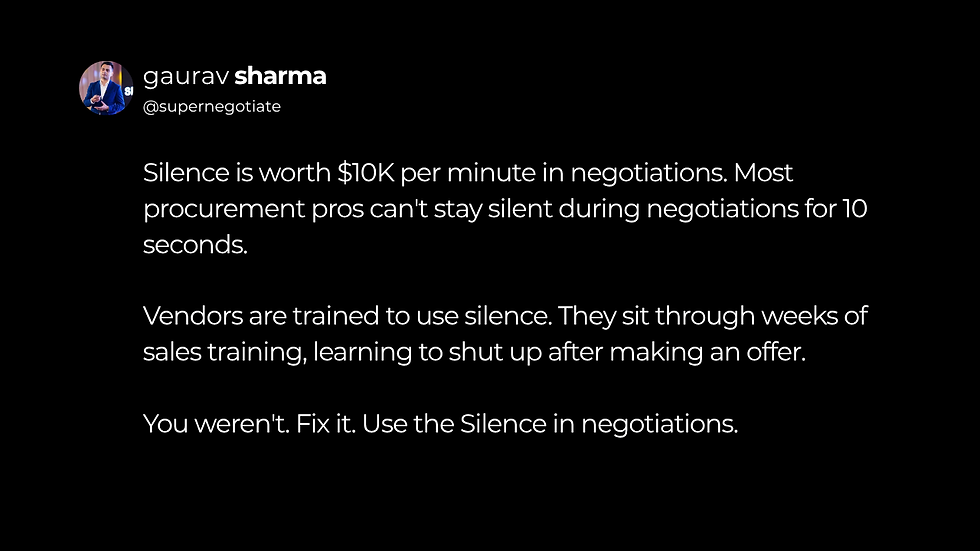The Procurement Paradox: Are you operating at Level 3 in Procurement or Level 1?
- Gaurav Sharma
- 7 days ago
- 2 min read
When I entered the Procurement profession in 2008, I focused only on one part—getting more cost savings by negotiating hard.

However, this created several problems:
1) Short-term thinking: A 20% discount achieved on paper was felt by my stakeholders in terms of quality issues & delivery delays
2) Strained relationships: Supplier relationships became transactional and contentious
Level 2: Senior Buyers
As buyers mature, they focus on TCO (Total Cost of Ownership): TCO includes
- Purchase price
- Implementation and onboarding costs
- Maintenance and support fees etc
Example: A manufacturing company might choose between two machines:
Machine A: $500,000 capex, $50,000 opex, 95% uptime
Machine B: $750,000 capex, $20,000 opex, 99.5% uptime
A junior buyer (like me in 2008) sees a 50% savings on Machine A.
Senior buyer calculates TCO over 10 years, factoring in downtime costs (lost production), and realizes Machine B delivers $2M more value despite a higher purchase price.
Senior buyers build business cases rather than simple % savings.
I’d consider myself at Level 2, but I want to go to Level 3. Here is how Level 3 operates.
Level 3 and the Dig deeper approach!

a) What business problem are we actually trying to solve?
- Are we bottlenecked on production capacity?
- Are we entering a new market segment?
- Are there any quality issues?
Discovery: The company is trying to win a contract with a Fortune 100 customer who requires 99.9% on-time delivery with zero defects.
b) What’s the business model impact, beyond cost impact?
- Machine A’s 95% uptime = 438 hours/year of downtime
- Machine B’s 99.5% uptime = 44 hours/year of downtime
Here’s what the Level 2 analysis missed:
A) With Machine A (95% uptime): We cannot guarantee 99.9% on-time delivery
- It will NOT win us the Fortune 100 contract
- Revenue opportunity: $0
B) With Machine B (99.5% uptime):
- Can commit to 99.9% on-time delivery
- Will win the Fortune 100 contract
- Revenue opportunity: $50M over 5 years
- Gross margin (30%): $15M in profit
Suddenly, this isn’t a “$2M savings” decision. It’s a “$15M+ revenue enablement” decision.
C) What does a strategic partnership look like?
Level 3 buyer calls Machine B supplier’s CEO, “I see you have a beta AI-predictive maintenance POC ongoing. We have a problem you might find interesting: we need to predict failures 48 hours in advance to meet our customers’ requirements. Can we become a development partner on your AI system and build together?”
D) Lastly, and my favourite: What competitive moats can I create?
A strategic mindset. If we partner with Machine B supplier on AI-predictive maintenance:
Year 1: We get 99.5% uptime (enough to win the contract)
Year 2: Production AI system gets us to 99.9% uptime
Year 3: We have 18-month exclusivity on the technology
Competitive impact: Our competitors cannot match our reliability, even if they buy Machine B, because they don’t have the AI system yet!
Thoughts?
Follow me on LinkedIn for more such content:



Comments